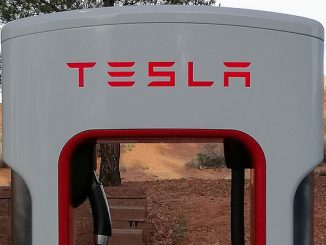Tesla Motors (TSLA) stock was trading one point lower in early trade Tuesday on reports of an Securities and Exchange Commission [SEC] inquiry into whether the automaker has violated securities laws by not informing investors about the May 7 fatal crash involving the use of Tesla’s new autopilot function. The accident killed the driver, Joshua Brown, a 40-year-old Tesla-Model S owner who was behind the wheel of his car when it collided with an 18-wheeler truck that pulled in front of him on a highway near Williston, Florida. Although Tesla immediately reported the accident to the National Highway Traffic Safety Administration [NHTSA], the U.S. car-safety regulator, it failed to disclose the crash to investors in a securities filing.
Following a Fortune report where the electric car maker was accused of misleading investors, Tesla said the event was not a “material” one requiring disclosure. Fortune however, claimed that eleven days after Brown died, Tesla and CEO Elon Musk, in combination made $2 billion by selling stock on May 18 in a public offering at $215 per share without disclosing the May 7 crash, which the company and founder-CEO knew about at the time.
“To put things baldly, Tesla and Musk did not disclose the very material fact that a man had died while using an auto-pilot technology that Tesla had marketed vigorously as safe and important to its customers.
That the fact was indeed “material” can be at least mildly suggested by the immediate fall in Tesla’s stock price on Friday morning. In a market that was then generally rising, Tesla stock dropped from Thursday’s close of $212 to a low of $206. But then the market reversed itself. By the end of the trading day, the stock had climbed above $216.”
In a blog post on July 6 titled “Misfortune”, Tesla rejected the publication’s report written by high-profile journalist Carol Loomis, calling it “fundamentally incorrect” as it had mischaracterized an SEC filing from the company.
“The bottom line is that Fortune jumped the gun on a story before they had the facts,” Tesla wrote. Elon Musk went as far as calling it “BS”. Now however, the SEC appears to be investigating Fortune‘s allegations.
The reported SEC investigation is the latest in a string of worrisome developments for Tesla as a company and its autopilot technology which continues to draw intense scrutiny in the media.
Over the weekend, a driver in Montana crashed his Tesla Model X and told the Montana Highway Patrol that “the car was in Autopilot at speed between 56-60 mph” on a road without a center divider. And NHTSA is looking into a July 1 crash in Pennsylvania involving a Tesla Model X sport utility. The car flipped upside down while it was in self-driving mode, its driver said.
Tesla’s autopilot technology is still in beta testing, otherwise known as the process of testing software that’s not completely done yet. Drivers have to actively engage the semi-autonomous driving systems, and the vehicles warn drivers to keep their hands on the wheel.
“Point of calling it ‘beta’ was to emphasize to those who chose to use it that it wasn’t perfect,” Musk said on Twitter (TWTR).
Tesla’s Autopilot features are available on more than 70,000 vehicles worldwide.
Stock Action
Tesla shares were trading lower pre-market. The stock began trading in regular hours at $224.06 to currently trade 0.35 percent higher from the prior days close of $224.78. On an intraday basis ticker has gotten as low as $223.22 and as high as $227.50.
Tesla is trading well off its $286.65 all-time high. Shares are down 13 percent year-over-year and more than 6 percent since January 1. Based on next year’s current estimates of ($7.83), Tesla trades with a P/E well over 72. Any time just about any company trades with a P/E that high, the expectations is for long term sustainable and rapid growth. That said, Tesla’s weaknesses include a deteriorating net income – currently negative at $1.02 billion, disappointing return on equity – (113%), poor profit margins and poor growth in its EPS. A continuation in the long-term perception of the current trend, in addition to the numbers we just mentioned, could change the stock’s price-per-share accordingly.
- Bulenox: Get 45% to 91% OFF ... Use Discount Code: UNO
- Risk Our Money Not Yours | Get 50% to 90% OFF ... Use Discount Code: MMBVBKSM
Disclaimer: This page contains affiliate links. If you choose to make a purchase after clicking a link, we may receive a commission at no additional cost to you. Thank you for your support!





Leave a Reply